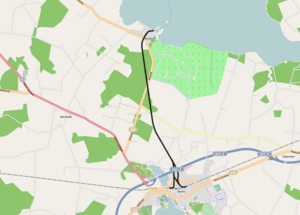Maribo – Bandholm railway line
| Maribo – Bandholm | |||||||||||||||||||||||||||||||||||||||||||||||||
|---|---|---|---|---|---|---|---|---|---|---|---|---|---|---|---|---|---|---|---|---|---|---|---|---|---|---|---|---|---|---|---|---|---|---|---|---|---|---|---|---|---|---|---|---|---|---|---|---|---|
|
Bandholm train station
| |||||||||||||||||||||||||||||||||||||||||||||||||
|
Maribo – Bandholm railway line
| |||||||||||||||||||||||||||||||||||||||||||||||||
| Route number : | MBJ | ||||||||||||||||||||||||||||||||||||||||||||||||
| Route length: | 7.5 km | ||||||||||||||||||||||||||||||||||||||||||||||||
| Gauge : | 1435 mm ( standard gauge ) | ||||||||||||||||||||||||||||||||||||||||||||||||
|
|||||||||||||||||||||||||||||||||||||||||||||||||
The Maribo – Bandholm railway is a Danish railway line. The standard gauge line from Maribo to Bandholm on the island of Lolland was built by the private railway company Maribo-Bandholm Jernbane Selskab (MBJ).
history
As early as 1861 there were the first plans for a horse-drawn railway from Maribo to Bandholm. The port of Maribo was in Bandholm. There was great demand for goods to be transported to and from Maribo by sea. The idea of the horse-drawn tram was soon abandoned and in 1869 the Det Lollandske Jernbaneselskab railway company received a concession for a normal railway line between the towns. The 7.5 km long line was built so quickly that the newly founded Maribo – Bandholm Jernbane Selskab was able to start operations on November 3rd of the same year.
Maribo – Bandholm Jernbane Selskab
In Maribo a temporary station was built at Quades gård , while a new station building was built in Bandholm. Two tank locomotives with a B1 wheel arrangement were purchased from Robert Stephenson in Newcastle upon Tyne , England for operation . For this purpose six passenger cars, two baggage cars and 15 freight cars were procured. The center of operations was Bandholm. The transports to the islands of Askø , Fejø and Femø were handled via the port .
With the opening of the Nykøbing Falster – Nakskov railway line built by Det Lolland – Falsterske Jernbaneselskab (LFJS) in 1874, the line was connected to the rest of the Danish rail network. The train station in Maribo no longer met the requirements and the MBJ's trains could use the new LFJS station in Maribo. Due to the location of the station, the entrance to the station has to be done with a saw drive backwards.
In 1896 MBJ and LFJS formed a joint administration, locomotives and vehicles were used jointly by both companies, and the two steam locomotives of MBJ were sold. In 1927, a three-axle triangle petrol motor car was purchased, which was used to drive most passenger trains until 1941. That year the railcar burned out and was parked. Freight trains were driven by LFJS locomotives. After the war, the number of promotions decreased. Therefore, on October 3, 1952, passenger traffic was stopped.
On July 1, 1954, after the dissolution of Det Lolland-Falsterske Jernbaneselskab A / S Lollandsbanen took over the management. Maribo – Bandholm Jernbane Selskab was dissolved on September 13, 1954 and incorporated into A / S Lollandsbanen . Freight traffic continued.
Museum railway of the Dansk Jernbaneklub
The Dansk Jernbaneklub (DJK) has been operating the Maribo – Bandholm museum railway between Maribo and Bandholm since 1962 .
Individual evidence
- ↑ Bandholmbanen, steam locomotive. jernbanen.dk, accessed February 17, 2014 (Danish).
- ↑ Bandholmbanen, motor locomotives. jernbanen.dk, accessed February 17, 2014 (Danish).
Web links
- Museum ban Maribo-Bandholm. History. Dansk Jernbane-Klub, accessed February 16, 2014 (Danish).
- Maribo – Bandholm. (PDF; 603 kB) Beretning om drift 2005/2006. Retrieved February 16, 2014 (Danish).

